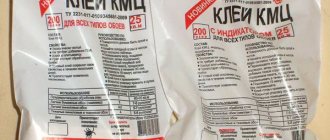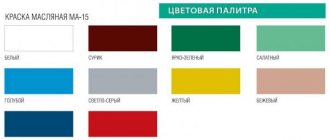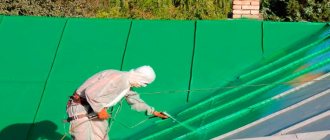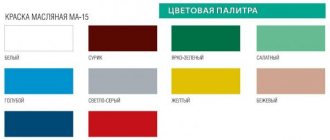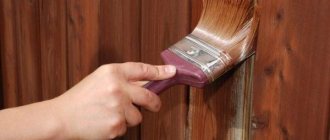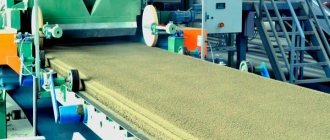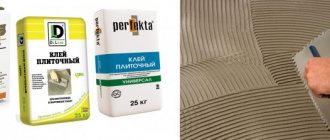I wanted to dry the floors in my dacha; by the way, it turned out to be last year’s can of drying oil. However, the problem is that over the course of a year it had thickened somewhat, and it had to be diluted with a solvent before being applied to the boards. I decided to share in this review how to dilute drying oil if it has thickened, as well as what types there are, how they differ, where they are used, how the procedure for diluting it is generally carried out, and what mistakes should not be made.
Source 5domov.ru
What is drying oil and where is it used?
Drying oil is intended for processing wooden and metal surfaces. It acts as a base for oil paints, a means of preventing the penetration of moisture. It is used before painting the product and improves the quality of adhesion of the coloring agent to the surface.
Interesting materials:
What is the root of the word pasture? What is the root of the word bee? What is the root of the word play? What is the root of the word pedestrian? What is the root of the word five? What is the root of the word pie? What is the root of the word pies? What is the root of the word letter? What is the root of the word whitewash? What is the root of the word coast?
Dilution at home
First of all, it is worth remembering that drying oil is a fire hazardous material; under certain conditions it can even cause an explosion.
Therefore, it must be diluted under controlled conditions:
- in rooms with good ventilation;
- away from sources of fire;
- proven compositions.
If you are working with a material whose composition is unknown to you, you should only dilute it while wearing gloves, since chemical burns may occur if it comes into contact with the skin. After you have carried out the work of diluting drying oil, you need to tightly close it with a lid, remove it from direct sunlight, and prevent excessive heating of the container.
Suitable for dilution:
- Solvent white spirit;
- Castor oil;
- Any other factory solvent for oil paint.
In this case, it is recommended to add only 1 part of solvent to 10 parts of drying oil, no more, since the physicochemical properties are lost.
Many home craftsmen try to “reanimate” drying oil that has been in a closed container for more than a year. Even if it remains liquid, transparent, and no sediment has formed, the composition is not suitable for use and can cause more harm to the builder than good.
You should not use drying oil that is a year old - it is more harmful than useful
When diluting synthetic drying oil, you must follow all the manufacturer's recommendations, since the solvent can completely ruin it.
When diluting drying oil, which has the properties of hardening, you should not count on the complete restoration of its properties, one of which is its covering ability. If you are confident in the quality of the protective material and observe sedimentation and the formation of a film, you can simply strain the drying oil through a metal strainer. This will prevent small particles of sediment from getting onto the surface being treated and will ensure its smoothness.
Skeptics argue that the process of diluting drying oil is completely pointless, since the polymerization process has already taken place. Of course, the original properties and qualities of drying oil will not be restored, however, by increasing fluidity, improving viscosity, and penetrating abilities, drying oil can be used in areas where high quality processing is not required.
Turpentine and synthetic paint liquids can also be used as a solvent. Sometimes it helps to add drying oil of the same type to the frozen container. It is important to monitor the reaction of the frozen material so that a precipitate does not form abruptly due to the effects of aggressive chemicals. It is best to add the solvent liquid gradually.
How to dilute drying oil based on natural oils
It is worth remembering that natural drying oil is a substance with an increased fire hazard; if the rules and safety precautions are not followed, it can easily ignite. It is necessary to figure out how to dilute natural drying oil in everyday life. If you decide to resort to this, then you need to follow a number of rules: carry out the work process in a room with a functioning ventilation system, away from sources of ignition and only with proven liquids to dissolve thickened drying oil.
To dilute drying oil of this composition, castor oil, white spirit solvent, various organic acids, turpentine or solvents for oil-based paints are used. The dilution process is simple: you need to take a little oil drying oil and dilute it, observing the resulting reaction.
Why do you need to dilute drying oil?
This oily product is used to impregnate wood and porous surfaces. The impregnation is absorbed into the wood, protects it and prevents rotting. The walls are soaked in the oily mixture before painting. The liquid is used to dilute paints (oil). In any of these cases, the impregnation should have a liquid consistency.
The oily product is diluted to:
- make it less thick;
- restore operational properties;
- save on buying a new product.
During long-term storage the mixture becomes thick. This occurs due to the thickening of oils. Oily impregnation hardens if it is stored in a jar with an open lid or the container is often opened. If the liquid has not completely dried out, but has only thickened, then it can be diluted. The type of thinner is selected depending on the type of impregnation.
Breeding mistakes
It is not recommended to use gasoline, kerosene or diesel fuel as a solvent. Drying oil can be diluted, but the fire hazard increases sharply. In addition, the application of such a composition in residential premises is prohibited.
Immediately after finishing work, you must wash all tools with soap or other detergent. Otherwise, it will end with polymerization (hardening) of the material and damage to the instrument.
To properly dilute drying oil, you only need to know its types and properties. Knowing all this, you can easily select one of the existing thinners. You will learn more about it and its dilution from the written article.
Today, as a rule, you can see a huge amount of building materials that are usually used in any construction of various premises, as well as in finishing work in them.
In addition, there are also many different mixtures that people simply cannot do without, usually during renovation or construction of a room. This necessary mixture also includes drying oil, which is now used in construction for a wide variety of purposes.
Thus, its most popular use, which has been known since ancient times, is the coating of wooden products for their high-quality impregnation. By impregnating wooden products with drying oil, people protected them from rotting and the negative effects of wood parasites. Previously, people could make this mixture themselves. However, now preparing it yourself is also not a problem. The most important thing you need to know in preparing this mixture is how to properly dilute the drying oil, and what ingredients are needed for this.
Nowadays, drying oil is used not only for impregnating wooden products, but also in enterprises that work with a variety of paints and varnishes. Thus, using this mixture you can dilute the paint, thereby giving the paint the property of quick drying. Thanks to the mixture, the paint adheres better to the surfaces that are painted with it.
Drying oil oxol
The composition of semi-natural drying oil (oxol) includes natural vegetable oils and solvents that have undergone long-term heat treatment. Its composition is dominated by solvents, which is why the product has an unpleasant specific odor, which sometimes persists even after drying on the surface being treated. The color of the drying oil of the existing composition is light brown or brown. Has the property of drying quickly. The main task of this type of drying oil is to protect wooden surfaces from parasites and moisture; after covering the products with it, a protective film is formed. It has also become widespread in the paint and varnish industry; it is used in the production of paints and for diluting them in the process of performing interior and exterior painting work. The surfaces of products primed with such drying oil acquire a good shine, high strength, and become water resistant. In terms of cost, drying oil oxol is very economical and much more profitable than natural options.
Is it possible to paint wood with drying oil?
Drying oils can be used as independent protection for wooden products, as a decorative dark coating, as a regular primer before finishing painting or filling untreated wooden surfaces, and as an additive for the preparation of various paint and varnish compositions.
Interesting materials:
Is it possible to give soap for New Year? Is it possible to drive on winter tires all year round? Is it possible to have red in the year of the Ox? Is it possible to stay for a second year in Ukraine? Is it possible to leave a child for a second year? Is it possible to celebrate a birthday at 33? Is it possible to grow hair in a year? Is it possible to transfer additional leave for harmful activities to the next year? Can I apply one year before the wedding? Is it possible to prepare for the Unified State Exam in computer science in a year?
Drying oil - what is it, varieties, application
Drying oil is a liquid paint and varnish based on natural oils or synthetic substances. Depending on the composition and purpose, it is produced by mechanical mixing of the components, or heat treatment, or chemical interaction of the components. After applying it to the surface and drying, a thin film with protective and decorative properties is formed.
It is used both as part of various paints, primers, coloring mixtures, and in its own form. In its pure form, it is often used to coat wood structures in order to make them resistant to moisture, temperature changes, as well as rot, mold and insects. The product may contain various types of additives to impart the desired properties to the treated surface - strength, durability, color, etc.
Source decoration-rooms.rf
According to its composition, it is divided into 4 main types:
- Natural.
It is produced on the basis of vegetable oils - sunflower, castor, linseed, hemp, tung, etc. Thanks to this, these same oils, if necessary, can dissolve thickened drying oil. The composition may also include wax, esters and resins. Due to the naturalness of the components and their minimal volatility, the composition does not thicken for a long time and is in a liquid state, does not evaporate toxic components when drying after application, but at the same time it is more expensive than other modifications.
There are several main subtypes of natural drying oil:
- Hemp. Made from hemp oil, it has a dark shade. Purpose – coating of wooden and metal products, plastered surfaces. Also included in oil paints and putties.
- Linen. Based on linseed oil. In most cases it is a clear liquid. Used for pre-priming. The main feature is quick drying after application, no more than 1 day.
Source himproduct.com.ua
- Sunflower. Made from sunflower oil. Characterized by elasticity. Disadvantages - minimal water resistance and strength of the layer, as well as long hardening.
Natural modification is often dissolved with readily available cheap sunflower oil, especially when used to treat non-residential premises - attic, rafters, basement, etc.
- Semi-natural.
Drying oil-oxol or semi-natural is made from natural oils similar to those discussed above, but with the addition of heat-treated solvents. Because of this, the product has a characteristic specific odor, which sometimes persists even after the treated surface has dried.
This type of drying oil, unlike the one described above, is characterized by faster drying - for the reason that it contains evaporated solvents, which can also be used to dilute it if necessary. The characteristic color is brown and light brown. It is used for both external and internal surface treatment.
Source 5domov.ru
- Combined.
It is made by mixing natural and synthetic bases after heat treatment. Used for painting and priming. Dries in less than a day.
- Synthetic.
The base uses only synthetic components. They differ in different compositions, shades and properties. Can be applied to wood and other types of surfaces.
Advice! To dilute drying oil, it is necessary to conduct a preliminary experiment using a small amount of it. This will ensure that the type and amount of solvent is correctly selected, as well as the preservation of its properties after dilution.

